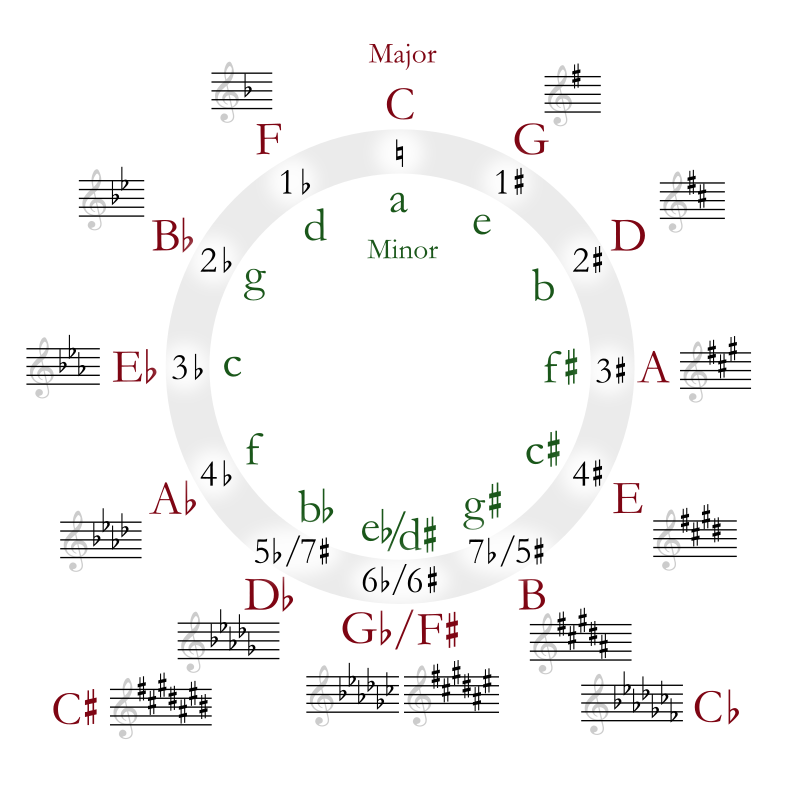
Toronto Piano Lessons: What is the Circle of Fifths?
2024-12-29 - Alvin

What is the Circle of Fifths?
The Circle of Fifths is a diagram that arranges all twelve pitches of the chromatic scale in a circular pattern. The relationships between the notes are based on intervals of a perfect fifth. As you move clockwise around the circle, each note is a perfect fifth above the previous one.
The Circle of Fifths not only helps visualize the relationships between pitches but also demonstrates key signatures, which are fundamental to understanding how music is structured.
How Does It Work?
Let’s break down the structure of the Circle of Fifths:
Starting Point: C Major
- The top of the circle is usually where C major is placed. C major is special because it has no sharps or flats in its key signature.
Clockwise Motion: Sharps and Key Signatures
- Moving clockwise, each step around the circle represents a key that is a perfect fifth above the previous one.
- From C (no sharps or flats), the next key is G major, which has one sharp (F#). Then, you move to D major, with two sharps (F# and C#), and so on.
Counterclockwise Motion: Flats and Key Signatures
- Moving counterclockwise from C, you get the keys with flats.
- First, you reach F major (one flat, B♭), then B♭ major (two flats, B♭ and E♭), and so on.
In this way, the Circle of Fifths shows you the pattern of how sharps and flats increase or decrease as you move through different keys.
Why is it called the Circle of Fifths?
The term “circle of fifths” comes from the fact that each step around the circle represents an interval of a perfect fifth between each key. A perfect fifth is an interval that spans seven half-steps (or semitones).
For example:
- The interval from C to G is a perfect fifth because there are seven half-steps between the two notes (C, C#, D, D#, E, F, F#, G).
- As you move clockwise around the circle, the notes keep getting a fifth higher. From G to D is a perfect fifth, from D to A, and so on.
This interval structure creates a smooth, predictable progression that helps musicians navigate key changes, modulations, and harmonies.
Understanding Key Signatures with the Circle of Fifths
- The Circle of Fifths is incredibly useful for quickly determining the key signature of any major or minor key.
Clockwise (Sharps):
- As you move clockwise around the circle, the number of sharps in each key increases by one. For example:
- G major has 1 sharp: F#.
- D major has 2 sharps: F# and C#.
- A major has 3 sharps: F#, C#, and G#.
Counterclockwise (Flats):
- Moving counterclockwise from C major, you add one flat at a time. For example:
- F major has 1 flat: B♭.
- B♭ major has 2 flats: B♭ and E♭.
- E♭ major has 3 flats: B♭, E♭, and A♭. ß You can use the circle as a quick reference to figure out which sharps or flats belong to a particular key.
The Circle of Fifths and Minor Keys
The Circle of Fifths also includes the relative minor keys, which share the same key signature as their major counterparts. Each major key has a corresponding minor key that is a minor third below it.
- C major and A minor share the same key signature (no sharps or flats).
- G major and E minor share the same key signature (1 sharp, F#).
- D major and B minor share the same key signature (2 sharps, F# and C#).
The relative minor keys are often shown as smaller circles within the main circle, positioned in the inner ring. You can easily find the relative minor of any major key by moving three steps counterclockwise.
How to Use the Circle of Fifths in Composition
Key Modulation
- The Circle of Fifths makes it easy to understand how to move between keys. Modulating (changing the key) can be as simple as moving a fifth up or down the circle. For example, if you’re in the key of C major, moving to G major (a fifth above) is a natural progression.
Chord Progressions
- Many of the most common chord progressions are based on the Circle of Fifths. For instance, the I-IV-V-I progression (C-F-G-C in the key of C major) uses chords that are directly adjacent to one another on the circle.
- You can create smoother, more harmonious progressions by using chords close to each other on the circle.
Improvisation
For improvisers, the Circle of Fifths can be a helpful tool for navigating chord changes and creating melodies. By understanding the relationships between keys, you can experiment with different scales, arpeggios, and modes that fit within the circle’s structure.
Practical Tips for Using the Circle of Fifths
- Learn the key signatures: Spend some time memorizing how the sharps and flats appear in different keys as you move around the circle.
- Explore chord relationships: Try writing chord progressions based on the circle and see how different intervals between chords affect the feel of the music.
- Key changes and modulation: Use the Circle to explore smooth modulations between keys, or experiment with moving a fifth up or down to change the key in your compositions.
- Understand scale construction: The Circle of Fifths is also a great way to visualize how different scales relate to one another, from major scales to modes and even chromatic scales.